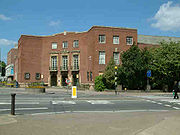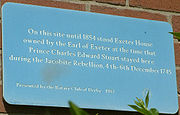
Exeter House
Encyclopedia
  |
- For Exeter House, London see Exeter ExchangeExeter ExchangeThe Exeter Exchange was a building on the north side of the Strand in London, with an arcade extending partway across the carriageway...
Exeter House was an early 17th century brick-built mansion, which stood in Full Street, Derby until demolished in 1854. Named for the Earls of Exeter
Marquess of Exeter
Marquess of Exeter is a title that has been created twice, once in the Peerage of England and once in the Peerage of the United Kingdom. The first creation came in the Peerage of England in 1525 for Henry Courtenay, 2nd Earl of Devon...
, whose family owned the property until 1757, the house was notable for the stay of Charles Edward Stuart
Charles Edward Stuart
Prince Charles Edward Louis John Casimir Sylvester Severino Maria Stuart commonly known as Bonnie Prince Charlie or The Young Pretender was the second Jacobite pretender to the thrones of Great Britain , and Ireland...
during the Jacobite Rising of 1745
Jacobite Rising of 1745
The Jacobite rising of 1745, often referred to as "The 'Forty-Five," was the attempt by Charles Edward Stuart to regain the British throne for the exiled House of Stuart. The rising occurred during the War of the Austrian Succession when most of the British Army was on the European continent...
. Exeter House was replaced by offices, which in turn were replaced by Charles Aslin's Magistrates Courts, built on the site during 1935. The Courts were closed at the beginning of 2004. This building now stands empty and boarded up, its fate not yet decided by the City Council.
This is where Charles Edward Stuart
Charles Edward Stuart
Prince Charles Edward Louis John Casimir Sylvester Severino Maria Stuart commonly known as Bonnie Prince Charlie or The Young Pretender was the second Jacobite pretender to the thrones of Great Britain , and Ireland...
("Bonnie Prince Charlie" or "The Young Pretender") took up residence on 4 December 1745. His host was the widowed mother of Samuel Ward
Samuel Ward (taster)
Samuel Ward owned property in Derby and Richmond in England. As a boy he was food taster to Bonnie Prince Charlie and was rewarded with a diamond ring which is now in the collection of Derby Museum and Art Gallery along with his portrait by Joseph Wright.-Biography:Ward lived in Derby...
. Ward was employed as the Young Pretender's food taster.
On the morning of 5 December a Council of War was called at Exeter House. The commander of the prince's forces, Lord George Murray
Lord George Murray (general)
Lord George Murray was a Scottish Jacobite general, most noted for his 1745 campaign under Bonnie Prince Charlie into England...
, argued that the lack of support from the French and from English Jacobites made success unlikely and retreat necessary. The prince was opposed to a retreat, and some members of the Council objected strongly and aggressively to giving up their advance on London. Meeting with the Council again later in the day, the prince took the decision to retreat, and he left Exeter House the following morning. He gave Ward's mother a diamond ring in thanks for their service before he left. The decision to retreat meant that the Young Pretender would not take George II
George II
George II may refer to:* George II of Abkhazia * George II of Georgia * Yuri II of Vladimir or George II * George II of Bulgaria * George II of Kakheti * George II of Imereti...
's crown and his army returned to Scotland, where they were finally defeated in 1746 at the Battle of Culloden
Battle of Culloden
The Battle of Culloden was the final confrontation of the 1745 Jacobite Rising. Taking place on 16 April 1746, the battle pitted the Jacobite forces of Charles Edward Stuart against an army commanded by William Augustus, Duke of Cumberland, loyal to the British government...
.
After the death of the 8th Earl
Brownlow Cecil, 8th Earl of Exeter
Brownlow Cecil, 8th Earl of Exeter , known as the Honourable Brownlow Cecil from 1701 to 1722, was a British peer and Member of Parliament.-Life:...
in 1754, the house was sold in 1757 by his widow to John Bingham, Mayor of Derby
Mayor of Derby
Names of the Mayors for the Borough of Derby from the first that was chosen on the 3 July 1638 by the king's charter then granted to the town the two last bailiffs were the two first mayors Mr Mellor being proclaimed the 3rd day of July to be the mayor until Michaelmas and twelve months after but...
for that year. Bingham lived at the house until his death in 1773 after which, in 1795, Jedediah Strutt
Jedediah Strutt
Jedediah Strutt or Jedidiah Strutt – as he spelt it – was a hosier and cotton spinner from Belper, England.Strutt and his brother-in-law William Woollat developed an attachment to the stocking frame that allowed the production of ribbed stockings...
purchased it. Strutt lived there until his death in 1797. The last owner was a lawyer, William Eaton Mousely, twice Mayor of Derby, who, after making some alterations in the 1830s, had the house demolished in 1854, believing Exeter House to be too large to maintain, and also to allow improvements to Exeter Bridge.
On visiting Exeter House in 1839 Lord Stanhope
Philip Henry Stanhope, 4th Earl Stanhope
Philip Henry Stanhope, 4th Earl Stanhope FRS , was an English aristocrat, chiefly remembered for his role in the Kaspar Hauser case during the 1830s....
noted the drawing room on the first floor, the room in which the final Council of War was held, as being "…unaltered, it is all over wainscotted with ancient oak, very dark and handsome…". It was reached by a dark oak staircase, with carved balustrades. Another visitor, a Mrs. Thomson, described the house as standing back from Full Street within a small rectangular court. The wide staircase ascended from a small hall to the drawing room; on either side of the drawing room were small panelled rooms which had served as the bedrooms for the prince and his officers. A spacious drawing room on the ground floor (altered by Mousely) gave access to a long garden, enclosed between high walls, which led down to the riverside.
Mousely had intended to sell off the panelling from the house in separate lots. However an appeal by Michael Thomas Bass, Jr.
Michael Thomas Bass, Jr.
Michael Thomas Bass DL was a British brewer and member of the British House of Commons. Under his leadership, Bass became the largest brewery in the world and the best known brand in the United Kingdom...
, the Earl of Chesterfield
George Stanhope, 6th Earl of Chesterfield
George Stanhope, 6th Earl of Chesterfield PC , styled Lord Stanhope until 1815, was a British Tory politician, courtier and race horse owner...
and William Bemrose among others persuaded Mousely to call off the sales. The panelling of the drawing room was instead removed to the cellars of the Derby Assembly Rooms. It was later reassembled within the Derby Museum and Art Gallery
Derby Museum and Art Gallery
Derby Museum and Art Gallery was established in 1879, along with Derby Central Library, in a new building designed by Richard Knill Freeman and given to Derby by Michael Thomas Bass. The collection includes a whole gallery displaying the paintings of Joseph Wright of Derby; there is also a large...
.
Below is an extract from Stephen Glover's History of Derby (1843):

